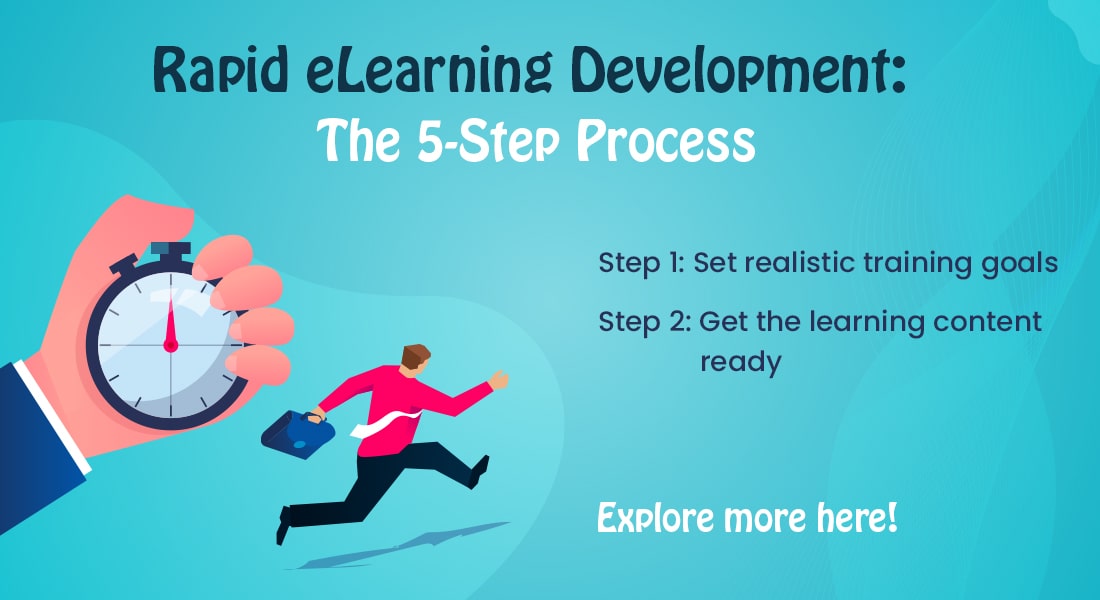Rapid eLearning Development: 5-Step Process to Win the Race Against Time

Chandler is the product training manager in a large consumer electronics company that is shortly launching a new model in their range of smart televisions. The management wants their sales and service people to be trained on the product before launch so that they can hit the ground running.
As the product is being launched simultaneously in all important cities (and because classroom training is not really feasible), they want to go for eLearning. Chandler had previously used eLearning to train his sales personnel and knows that it takes a minimum of 4-6 weeks for development. So, he’s scrambling for options.
Chandler is not alone in this predicament. Many corporate training managers face the same problem – of rolling out training quickly to meet their urgent training needs. Is there a solution we can offer them?
Yes, there is – rapid eLearning development!
What is Rapid E-learning Development and Why do You Need it?
Rapid e-learning development is a development methodology for online learning that is ideally suited for 21st century corporate needs. True to its name, this approach helps cut the time required to develop an eLearning course by at least 40%. This translates into reduced course development costs with reduced number of man hours needed to develop the course.
5 Steps to Develop High Quality Online Courses Quickly (and Win the Race Against Time!)
Step 1: Set clear, realistic training goals
Step 2: Get the learning content ready
Step 3: Select the right rapid authoring tool
Step 4: Leverage pre-built eLearning templates
Step 5: Adopt an agile process for development
With corporate L&D budgets getting thinner and thinner with each passing year, rapid e-learning development has emerged the best option to meet dynamic and urgent training needs, without burning a hole in the pocket.
What are the 5 Steps for Rapid eLearning Development?
Follow this 5-step process to develop high quality online courses, quickly.
Step 1: Set Clear, Realistic Training Goals
This is the most important (and unfortunately, the most neglected) step in the rapid eLearning development process. You need to have a clear picture of what you intend to achieve with the training program. Also, you need to set clear timelines for when it will be delivered and when you want to launch the program. Proper planning is key for the successful development of a good e-learning course within a tight time frame.
So, ask yourself these 4 questions to clarify in your own mind the goals of the training program:
- What do you want learners to be able to do after the training?
- How relevant is the training program to learners?
- Will the training be limited to a single eLearning module or will it be a curriculum with basic, intermediate, and advanced modules on a specific subject?
- Should learners be evaluated on their understanding of the subject at the end of the training?
Step 2: Get the Content for the eLearning Course Ready
So, now you know what you expect from the course. The next step is to get the learning content ready. We will be using existing classroom and other training materials for the course (that’s one of the reasons the development is rapid! The content is already there.) But, in most cases, the existing content is not complete in itself, and has a lot of gaps. That’s because the rest of the information is lodged in the instructor’s brain in the form of examples, stories, anecdotes, and so on, from where he imparts them to learners in the classroom.
As there will be no instructor in the eLearning course, the content needs to be made complete to flow in a logical fashion. Also, many instructor-led resources are not organized in a proper sequence (into units, sub-units, and lessons). This also needs to be addressed to make sure the content is ready for development.
Step 3: Select the Right Rapid Authoring Tool
The right tool is critical to the successful development of your e-learning course. Rapid authoring tools such as Articulate Storyline and Adobe Captivate are the cornerstones of the rapid eLearning development process. It’s easy to get lost looking at the hundreds of rapid authoring tools available in the market today, but when you look at them through the perspective of your organization’s needs, the selection becomes easy.
So, your choice is driven by your training need and the course strategy, the cost of the tool, its features, the learning curve for its use, etc. While some authoring tools such as iSpring help to quickly convert classroom PPTs to eLearning modules, others are suited to create more interactive courses.
Step 4: Leverage Templates Offered by Authoring Tools
Many rapid authoring tools come with in-built online course templates. Using them would drastically reduce the time and money needed to develop your learning materials. These templates can be customized to meet your needs and reused many times. They can be tweaked and standardized to provide a consistent look and feel for your courses that learners can recognize and relate to.
Step 5: Adopt an Agile Process for Development
Once you standardize the eLearning templates, it is time to move on to the final step of the rapid eLearning development process – the actual development of the course – best done through an agile process. The agile ‘Successive Approximation Model (SAM)’, created by Michael Allen overcomes the shortcomings of the ADDIE model.
Its three phases – preparation, design, development – follow an iterative process with constant communication between the design team and the stakeholders.

Keeping the stakeholders and SMEs in the loop ensures rework is kept to a minimum, and quality is not lost during the speedy roll-out of courses.
Wrap Up
Well, that was about the process of rapid e-learning development. Chandler used the process to great advantage and made his bosses and learners happy. Why don’t you also try it to develop your web-based learning resources quickly and with minimal expense, to meet your dynamic training needs?





